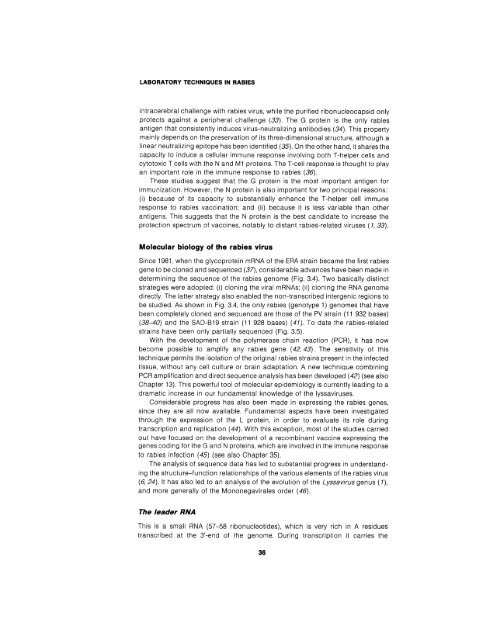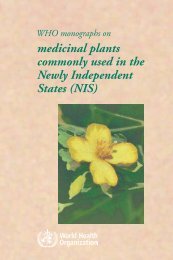in rabies - libdoc.who.int - World Health Organization
in rabies - libdoc.who.int - World Health Organization
in rabies - libdoc.who.int - World Health Organization
You also want an ePaper? Increase the reach of your titles
YUMPU automatically turns print PDFs into web optimized ePapers that Google loves.
LABORATORY TECHNIQUES IN RABIES<br />
<strong>in</strong>tracerebral challenge with <strong>rabies</strong> virus, while the purified ribonucleocapsid only<br />
protects aga<strong>in</strong>st a peripheral challenge (33). The G prote<strong>in</strong> is the only <strong>rabies</strong><br />
antigen that consistently <strong>in</strong>duces virus-neutraliz<strong>in</strong>g antibodies (34). This property<br />
ma<strong>in</strong>ly depends on the preservation of its three-dimensional structure, although a<br />
l<strong>in</strong>ear neutraliz<strong>in</strong>g epitope has been identified (35). On the other hand, it shares the<br />
capacity to <strong>in</strong>duce a cellular immune response <strong>in</strong>volv<strong>in</strong>g both T-helper cells and<br />
cytotoxic T cells with the N and M1 prote<strong>in</strong>s. The T-cell response is thought to play<br />
an important role <strong>in</strong> the immune response to <strong>rabies</strong> (36).<br />
These studies suggest that the G prote<strong>in</strong> is the most important antigen for<br />
immunization. However, the N prote<strong>in</strong> is also important for two pr<strong>in</strong>cipal reasons:<br />
(i) because of its capacity to substantially enhance the T-helper cell immune<br />
response to <strong>rabies</strong> vacc<strong>in</strong>ation; and (ii) because it is less variable than other<br />
antigens. This suggests that the N prote<strong>in</strong> is the best candidate to Increase the<br />
protection spectrum of vacc<strong>in</strong>es, notably to distant <strong>rabies</strong>-related viruses (1, 33).<br />
Molecular biology of the <strong>rabies</strong> virus<br />
S<strong>in</strong>ce 1981, when the glycoprote<strong>in</strong> mRNA of the ERA stra<strong>in</strong> became the first <strong>rabies</strong><br />
gene to be cloned and sequenced (37), considerable advances have been made <strong>in</strong><br />
determ<strong>in</strong><strong>in</strong>g the sequence of the <strong>rabies</strong> genorne (Fig. 3.4). Two basrcally dist<strong>in</strong>ct<br />
strategies were adopted: (i) clon<strong>in</strong>g the viral mRNAs; (ii) clon<strong>in</strong>g the RNA genome<br />
directly. The latter strategy also enabled the non-transcribed <strong>in</strong>tergenic regions to<br />
be studied. As shown <strong>in</strong> Fig. 3.4, the only <strong>rabies</strong> (genotype I ) genomes that have<br />
been completely cloned and sequenced are those of the PV stra<strong>in</strong> (1 1 932 bases)<br />
(38-40) and the SAD-B19 stra<strong>in</strong> (11 928 bases) (41). To date the <strong>rabies</strong>-related<br />
stra<strong>in</strong>s have been only partially sequenced (Fig. 3.5).<br />
With the development of the polyrnerase cha<strong>in</strong> reaction (PCR), it has now<br />
become possible to amplify any <strong>rabies</strong> gene (42, 43). The sensitivity of this<br />
technique permits the isolation of the orig<strong>in</strong>al <strong>rabies</strong> stra<strong>in</strong>s present <strong>in</strong> the <strong>in</strong>fected<br />
tissue, without any cell culture or bra<strong>in</strong> adaptation. A new technique comb<strong>in</strong><strong>in</strong>g<br />
PCR amplification and direct sequence analysis has been developed (42) (see also<br />
Chapter 13). This powerful tool of molecular epidemiology is currently lead<strong>in</strong>g to a<br />
dramatic <strong>in</strong>crease <strong>in</strong> our fundamental knowledge of the lyssaviruses.<br />
Considerable progress has also been made <strong>in</strong> express<strong>in</strong>g the <strong>rabies</strong> genes,<br />
s<strong>in</strong>ce they are all now available. Fundamental aspects have been <strong>in</strong>vest~gated<br />
through the expression of the L prote<strong>in</strong>, <strong>in</strong> order to evaluate its role dur<strong>in</strong>g<br />
transcription and replication (44). With this exception, most of the studies carried<br />
out have focused on the development of a recomb<strong>in</strong>ant vacc<strong>in</strong>e express<strong>in</strong>g the<br />
genes cod<strong>in</strong>g for the G and N prote<strong>in</strong>s, which are <strong>in</strong>volved <strong>in</strong> the immune response<br />
to <strong>rabies</strong> <strong>in</strong>fection (45) (see also Chapter 35).<br />
The analysis of sequence data has led to substantial progress <strong>in</strong> understand<strong>in</strong>g<br />
the structure-function relationships of the various elements of the <strong>rabies</strong> virus<br />
(6, 24). It has also led to an analysis of the evolution of the Lyssavirus genus (I),<br />
and more generally of the Mononegavirales order (46).<br />
The leader RNA<br />
This is a small RNA (57-58 ribonucleotides), which is very rich <strong>in</strong> A residues<br />
transcribed at the 3'-end of the genome. Dur<strong>in</strong>g transcription it carries the
















